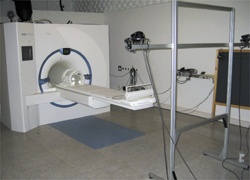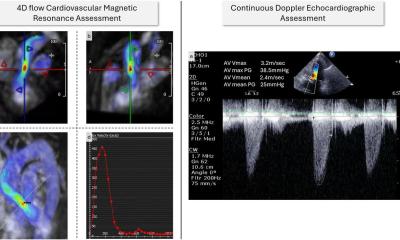The MRI-MARCB project
Adjusting for motion artifacts
Despite advances in magnetic resonance imaging (MRI) that have revolutionised diagnostic possibilities, e.g. for functional imaging (fMRI), motion artifacts are still extremely detrimental in multi-slice 3D sequences, often used in fMRI or with uncooperative patients (children, elderly, accidents, stroke...).

However, Philips has succeeded in compensating breathing artifacts by using data from ‘pencil navigators’, which can measure diaphragm movement in just 10ms. This technique went into clinical use this year.
In brain imaging, however, although some procedures have been developed to remove artifacts caused by patients’ head movements, their disadvantages include increased image acquisition time and a negative influence on scanner performance.
The EU project MRI-MARCB is aiming to produce an integrated solution to reduce motion effects in brain and cardiac imaging. Working within this project Christian Dold, research engineer at the Fraunhofer Institute of Computer Graphics in Darmstadt, Germany, explained: ‘The problem of motion compensation in MRI technology deals with capturing the source and pattern of motion; obtaining a mathematical model of motion, using this to identify and compensate for the motion effects, further for optimising the image acquisition sequence so as to minimise, or even eliminate, the effect of motion.’
In its research the Fraunhofer IGD is using an infrared optical tracking system with high precision (RMS about 0.1mm, FOV = 50x50x50cm) to track patients’ movements. By capturing ca. 20 movements per second in real-time - with parameters of six degrees of freedom (6DOF)- a volume-to-volume or a slice-to-slice prospective correction is made in the MR-tomograph during the scan and just before the next slice is captured to translate these movements into new gradients, so that the acquisition of each new volume/image corresponds to the new direction of the head.
As Christian Dold explained: ‘At the end of each volume/slice acquisition the MR scanner reads the co-ordinates from the tracking system and changes prospective the 3 MR field gradients and frequencies in the sequence prior of acquiring the next volume/slice. The result is a real-time prospective compensation for the complete head movement. This is based on the fact that the time needed to acquire a single k-space line is very much shorter than the time needed between acquiring subsequent k-lines. Hence, motions of the head during acquisition of a single k-line are negligible and effects of motion are visible between subsequent lines.’
The technique promises a significant reduction in imaging time by lowering the need for repeat scanning and will, he said, ‘... improve the quality and speed by imaging uncooperative patients and increase the efficiency of functional MRI, which is beneficial for surgical planning and neuroscience research.’ By compensating for patients’ restlessness during imaging (e.g. children, Parkinson’s patients, etc) this technique should also increase patient throughput and ‘reduce measurement redundancy’.
Details: www.mri-marcb.org
01.07.2004











